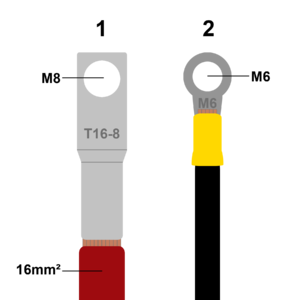Wire terminal
Jump to navigation
Jump to search
Terminals are used to make safe and lasting mechanical connections in electrical systems. Terminals that are mechanically crimped (compressed) with a tool are the standard for off-grid PV installations. A terminal must be properly chosen based upon:[1]
- The size wire that wil be inserted into it. Terminals will often be marked for the size wire that they will except like in the diagram.
- The size bolt that will be used to anchor it. Terminals should be marked for the size hole that they have.
- The stranding of the wire that it will be used with. Fine stranded battery cable may require larger terminals for it to be properly secured.
When crimping the terminal, the proper size crimping tool must be used to ensure a good connection. If an improper tool is used, it is likely that the connection will come lose and fail over time.
Insulated terminals
Insualted terminals for smaller wire gauges have been standardized using a simple color scheme that works for both AWG and mm² wire sizes.[2]
| Color | Standard metric size(mm²) | Standard AWG size |
|---|---|---|
| Red | .5-1 mm² | 22-16 AWG |
| Blue | 1.5-2.5 mm² | 16-14 AWG |
| Yellow | 4-6 mm² | 12-10AWG |
Notes
- ↑ Thomas & Betts Compression Terminal Catalogue http://www.tnb.com/pubint/docs/colorkeyed_spec.pdf
- ↑ PANDUIT terminal size chart http://www.innovative.com.mx/wp-content/uploads/2015/10/Metric-Ring-Terminal-Vinyl-Insulated-Funnel-Entry.png
